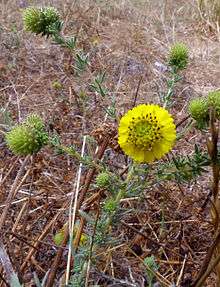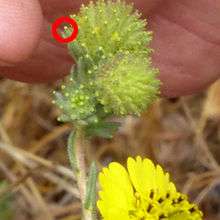Holocarpha macradenia
Holocarpha macradenia, commonly known as the Santa Cruz tarplant, is an endangered plant endemic to Northern California.[2] Alternative common names for this plant are Santa Cruz tarweed or Santa Cruz sunflower.
| Holocarpha macradenia | |
|---|---|
 | |
| The Santa Cruz tarplant is listed as threatened under the federal Endangered Species Act (ESA), and endangered under the state of California Endangered Species Act (CESA). | |
| Scientific classification | |
| Kingdom: | |
| (unranked): | |
| (unranked): | |
| (unranked): | |
| Order: | |
| Family: | |
| Genus: | |
| Species: | H. macradenia |
| Binomial name | |
| Holocarpha macradenia (DC.) Greene, 1897 | |
| Synonyms[1] | |
|
Hemizonia macradenia DC. 1836 | |
Distribution
The plant's principal range is on certain coastal terraces in Santa Cruz County and Monterey County. Smaller colonies are to the north in Alameda County, Contra Costa County, and Marin County.[3] It is found from sea level to 110 metres (360 ft).[2]
Specifically Santa Cruz tarplant likes to inhabit terraced locations of coastal or valley prairie grasslands with underlying sandy clay soils. Its characteristic habitat is in the California coastal prairie ecosystem, which may be the oldest stable ecosystem of the temperate world dating from about 600,000 years ago.
Description
Santa Cruz tarplant is an annual wildflower that can grow to 50 cm tall, but is often much smaller. The flowering period is June to November. The growth habit is a single erect stem with larger specimens developing branches. Its leaves are linear and manifest longer near the plant base. The lower ranging leaves exhibit sharp, short teeth at their edges, while the upper leaves present edges that are rolled back, leading to a bristly feeling. Several other species have a similar general appearance, and can be easily mistaken for the Santa Cruz tarplant. The real Santa Cruz tarplant, though, has distinctive glands (see photos) that are not present in lookalikes.


The aroma of the plant has variously been described as strong, citrusy, tangerine and Christmas Tree-like. The pungent smell protects it by repelling many would-be feeders.
It has characteristic yellow daisy-like flowers, with black anthers giving the appearance of striking black dots in the flower center. It is distinguished by its large number of flowers: 8 to 16 three-lobed outer ray flowers and 40 to 90 central disk flowers, more than any others in the genus Holocarpha. The flowers are situated in dense clusters at the branch tips or along the branch on a very short stem.
- Drought tolerance
The Santa Cruz tarplant has an extremely long tap root, allowing it to thrive longer into the season than most coastal wildflowers. The plant produces seedbanks, which may not germinate in the next season, but which can remain viable over a period of years. Blooming season is summer, when there is less competition for pollinators and also less competition for sunlight, since in its range many plants have died back from the summer drought. Further protection from the rainless summer is a resinous coating on leaves and stems, allowing retention of water until late in the season. These resins often adhere to livestock, and, in the case of facial adherence, lead to a mascara-like effect after dust adheres to the resin in turn.
Protection and current status
Santa Cruz tarplant had been considered almost extinct by the year 1960. Subsequently, it was listed as a California endangered species and federal threatened species.[4][2] Colonies are found in the city of Santa Cruz at the Arana Gulch greenbelt and near De La Veaga Golf Course, Twin Lakes, and along Graham Hill Road;[5] in the city of Watsonville in grasslands along Harkins Slough plus a 3.4 acre coastal prairie called Tarplant Hill next to Struve Slough,[6] Spring Hills Golf Course, and on Watsonville Airport property;[7] and in the Elkhorn Slough watershed at the Elkhorn Slough Foundation's Porter Ranch in Monterey County.[8]
In the 1980s other colonies were found in the San Francisco Bay Area, including a colony in Pinole, western Contra Costa County. Ex-situ conservation of that colony was used to allow construction of a new shopping center, and a limited number of seeds from that population were moved immediately across and east of Interstate 80 onto the CalTrans right-of-way.[9] Additional seeds from that population were moved onto East Bay Regional Parks property, where most of these introduced populations died.
In another touch-and-go experiment, Santa Cruz tarplant has been shown to barely hang on at the Arana Gulch colony in Santa Cruz, mostly due to lack of appropriate management, habitat fragmentation, and competition with non-native species. Active restoration experiments began in 2007 at Tarplant Hill in Watsonville by the owners, with support from the U.S. Fish and Wildlife Service Partners in Restoration Program.
Populations Protected as Critical Habitat
In 2002, the US Fish and Wildlife Service published the final designation of Critical Habitat for the species, as follows: UNIT A - Mezue (Contra Costa County, Wildcat Canyon Regional Park) - County/City ownership. UNIT B - Graham Hill - Private ownership. UNIT C - De Laveaga - State ownership. UNIT D - Arana Gulch - County/City ownership. UNIT E - Twin Lakes - State ownership. UNIT F - Rodeo Gulch - Private ownership. UNIT G - Soquel - Private and County/City ownership. UNIT H - Porter Gulch - Private ownership. UNIT I - Watsonville - State, County/City and Private ownership. UNIT J - Casserly - Private ownership. UNIT K - Elkhorn - Private ownership.
In 2002, a total of 1,175 ha (2,902 acres) was designated as Critical Habitat.[10]
Efforts at active management to restore plant populations
The Arana Gulch populations management, the City of Santa Cruz established their Adaptive Management Working Group (AMWG) which consisted of a group of stakeholders, whose composition was approved by the California Coastal Commission Executive Director. The members have been a researcher from UC Berkeley, a biologist from California Fish and Wildlife, a biologist from US Fish and Wildlife Service, an ecologist from the California Coastal Commission, three private consultants, a UC Cooperative Extension Livestock advisor, and Santa Cruz city staff from the Planning and Parks Departments. Semi-annual meetings were held from 2013 to 2016, with the last meeting March 14, 2016.[11]
Twin Lakes State Park (Unit D0 population management between 1998-2003 consisted of mowing in 1998, 1999, and 2001 once in spring, and once in fall using a string trimmer. The litter was then removed using garden rakes or McCleods. The site was scraped using McCleods. In 2002, mowing continued and 15 nursery raised plants planted on February 6. The nursery plants were more robust and produced over ten times the number of seed heads than the naturally occurring individuals.
In 2002, 494 plants were grown from seeds harvested in previous years, and 344 of these plant survived, but were no more robust than the naturally occurring individuals. In 2002, where plants naturally occurred, was mowed twice as well as treated with a chain harrow.[12]
Population trends in individual plant populations
Ecological restoration projects to restore individual populations of the plants, their annual reports usually contain plant counts or estimations of the numbers of plants with a population during a certain year, and that data can be used to measure trends and successes of the restoration techniques used.
The Arana Gulch (Unit D) population first census in 1986 by Randy Morgan estimated that there were 100,000 plants on that site in Santa Cruz, and by 2006 had dropped to only 348 plants. Plants counts in 2013 only found 18 plants, in 2014 only 4 plants, and in 2015 zero, and 2016 34 plants.
The Arana Gulch restoration methods tried so far, are burning, grazing annually with cattle, and scraping. Three of the four former plant population sites are surrounded by permanent barbed wire cattle fencing[13]
The "Tarplant Hill" population in Watsonville (part of the Unit I populations) has experienced an almost identical drop in the plant numbers in that population. The plant count in 1984, estimated 10,000 plants, 1985 100,000 plants, 1986 20,000 plants, 1989 400,000 plants, and in 1990, 38,000 plants were estimated. Then in 1993, 1994, and 2003 only a single plant was found for that whole "Tarplant Hill" population. Then, counts in 2004, found 8 plants, 2005 60 plants, 2008 two plants, 2007 70 plants, 2008 59 plants, and the 2009 count found 189 plants.
The Twin Lakes population, which is part of Unit D is on State Park property, and the naturally-occurring plant numbers were 16 in 1999, 7 in 2000, 19 in 2001, 7 in 2002 and only 5 plants in 2003.[14]
See also
References
- The Plant List, Holocarpha macradenia (DC.) Greene
- CalFlora . accessed 11.14.2011.
- Jepson . accessed 11.14.2013
- USDA: Legal status . accessed 11.14.2011.
- Santa Cruz County, California: Local Coastal Program Land Use Plan (1981)
- Report on Holocarpha macradenia Monitoring and Management at Watsonville Wetland Watch's Tarplant Hill Property
- Gary Deghi, C. Michael Hogan et al., Environmental Impact Report, Harkins Slough Area for the City of Watsonville, Earth Metrics Incorporated (1985)
- PelicanNetwork.net; article by Jane Strong, (2000).
- Gary Deghi, C. Michael Hogan et al., Final Environmental Impact Report of the Pinole Valley Shopping Center for the city of Pinole, Earth Metrics Incorporated (1986)
- 50 CFR Part 17. Endangered and Threatened Wildlife and Plants; Final Designation of Critical Habitat for Holocarpha macradenia (Santa Cruz Tarplant); Final Rule. pages 63968-63992. Vol. 67, No. 200, October 16, 2002, Rules and Regulations
- "Habitat Management at Arana Gulch" website http://www.cityofsantacruz.com/government/city-departments/parks-recreation/parks-beaches-open-spaces/open-spaces/arana-gulch/habitat-management-at-arana-gulch
- Report - "Management Actions and Population Trends For the Twin Lakes Population of Holocarpha macradenia Santa Cruz Tarplant September 1998 thru July 2003" N/D by Tim Hyland, California State Parks Resource Ecologist Santa Cruz District
- Arana Gulch Habitat Management Plan, City of Santa Cruz, Year 3 (2016) Annual Report.
- Report--"Management Actions and Population Trends For the Twin Lakes Population of Holocarpha macradenia Santa Cruz Tarplant September 1998 thru July 2003" N/D by Tim Hyland, California State Parks Resource Ecologist, Santa Cruz District.
- Restoration of Santa Cruz Tarplant (Holocarpha macrademia) and Coastal Prairie on Tarplant Hill, Santa Criz County. Cooperative Agreement #81440-7-J303. October, 2009. Annual report, reflects work accomplished during the time period September 1, 2007 - October 1, 2009
External links
| Wikimedia Commons has media related to Holocarpha macradenia. |
